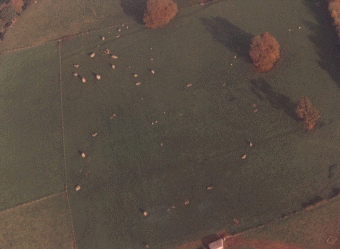Stanton Drew lies off the beaten track and it is perhaps for this reason that its remarkable prehistoric stone circles have not received the same level of interest and exploration as their more famous relatives at Avebury and Stonehenge. This obscurity, and the lack of modern intrusions into their surroundings, has protected the solitude and character of these sites. Very little is known about them. The great stones (or megaliths), and the patterns they make in the landscape, remain mysterious; no excavations are recorded, nor have any modern surveys been made - that is, until very recently. This note provides you with a very brief background to the site and of the results of this new research.
The megalithic sites
There are three stone circles at Stanton Drew: the Great Circle being one of the largest in the country. The other two, to the south-west and north-east respectively are smaller. Both the great Circle and the north-east circle were approached from the north-east by short `avenues' of standing stones. Most of the stones have fallen, although a few still remain upright. In the garden of the village pub is a group of three large stones called The Cove, and to the north, across the river Chew, is the site of a standing stone called Hautville's Quoit.
Their proximity to each other, and alignments between some of them, indicate that these sites are related as a single complex, and it is a fair assumption that Stanton Drew was once a place of primary significance during the later Stone Age.
History and folklore
The circles are thought to have been originally noted by the famous antiquarian John Aubrey in 1664, and the first plan of them was published by William Stukeley in 1776. Although several other observers have written about them, they remain very much as first recorded over three hundred years ago. In the absence of many facts about the sites, the stones have attracted a considerable tradition of folklore. The most persistent tale is that the stones represent the members of a wedding party and its musicians, lured by the Devil to celebrate on the Sabbath and thus becoming petrified in their revels.
Archaeology and recent survey
Stone circles such as those here are known to date broadly to the late Neolithic and early Bronze Age (approx 3000-2000 BC), and many examples are known, mostly from western and northern Britain. In southern England the stone circles and avenues at Avebury and Stonehenge testify to a long and complex history within a landscape dense in other evidence of prehistoric activity. The circles are believed to have played an important part in contemporary social and religious life, and there is evidence that some were aligned with major events of the solar and lunar calendar. They are difficult subjects to tackle archaeologically, though, and their interpretation is the subject of much discussion, a debate much enlivened by the interests and theories of the `New Age'.
Apart from the certainty that the stone settings at Stanton Drew share an affinity with ritual complexes such as Avebury, there is little material evidence to take this interpretation further. Contemporary prehistoric sites seem to be rare in the vicinity although they probably await discovery. In order to try and lift this veil of ignorance a little, and also to help improve the day-to-day management and presentation of the circles, English Heritage have recently initiated geophysical research at the site.
Geophysical survey
Geophysical survey is a method of examining an archaeological site without having to dig it up. Several techniques can be used, but the one that has so far proved most effective at Stanton Drew is magnetometry. This relies on the fact that all soil is slightly magnetic and that this magnetism is concentrated and enhanced in many types of archaeological feature. Measurements made with a portable magnetometer, carried across the site at regularly spaced intervals, allows a picture of the local magnetic field to be built up. Magnetic `anomalies' are revealed in the subsequent computer plots as patterns which indicate the presence of buried features such as pits, ditches and hearths.
![[Photo of Caesium Gradiometer]](cphotothumb.gif)
![[Caesium Gradiometer Survey Results]](caesthumb.gif)
Left: Caesium gradiometer survey in progress
[90.5 Kb JPEG].
Right: Caesium gradiometer survey of part
of the area within the great circle [65Kb GIF].
This more sensitive instrument resolves the individual pits more
clearly.
![[Comparison of Stanton Drew with other henges with timber circles]](compthumb.gif)
Comparison of Stanton Drew with other henges
with timber circles [19.5Kb GIF]

